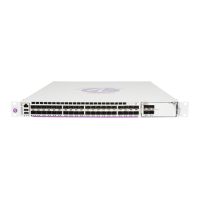Interface Configuration
7750 SR Interface Configuration Guide Page 61
On the ingress side, LFI requires that the ingress port can receive non-fragmented packets within
the fragment stream and pass these packets directly on to the forwarding engine and then continue
with the reassembly process for the fragmented frames.
Multi-Class MLPPP
Multi-class MLPPP (MC-MLPPP) allows for the prioritization of multiple types of traffic flowing
between the cell site routers and the mobile operator’s aggregation routers. MC-MLPPP is an
extension of the MLPPP standard which allows multiple classes of service to be transmitted over a
MLPPP bundle. Originally (Figure 7), link fragmentation and interleaving (LFI) was added to
MLPPP that allowed two classes, but in some applications, two classes of service can be
insufficient.
The MLPPP header includes two class bits to allow for up to four classes of service (Figure 8).
This enhancement to the MLPPP header format is detailed in RFC 2686, The Multi-Class
Extension to Multi-Link PPP. This allows multiple classes of services over a single MLPPP
connection and allows the highest priority traffic to be transmitted over the MLPPP bundle with
minimal delay regardless of the order in which packets are received.
The new MC-MLPPP header format uses the two (previously unused) bits before the sequence
number as the class identifier. This allows four distinct classes of service to be identified into
separate re-assembly contexts.
Figure 7: Original MLPPP Header Format Figure 8: MC-MLPPP Short Sequence Header Format
Address 0xff
E
Control 0x03
PID(L) 0x3DPID (H) 0x00
Seq. NumberB E 0 0
Fragment Data
…..
FCS
Address 0xff
E
Control 0x03
PID(L) 0x3DPID (H) 0x00
Seq. NumberB E 0 0
Fragment Data
…..
FCS
CLS

